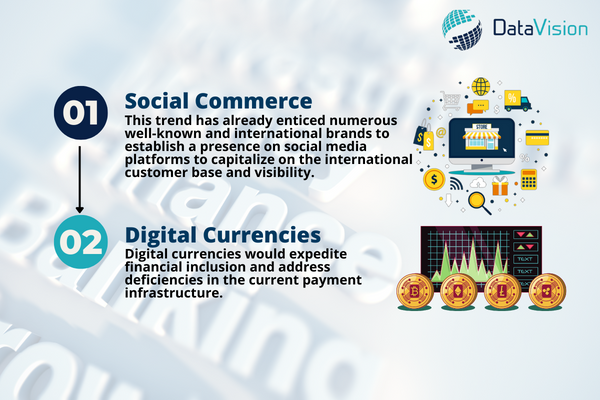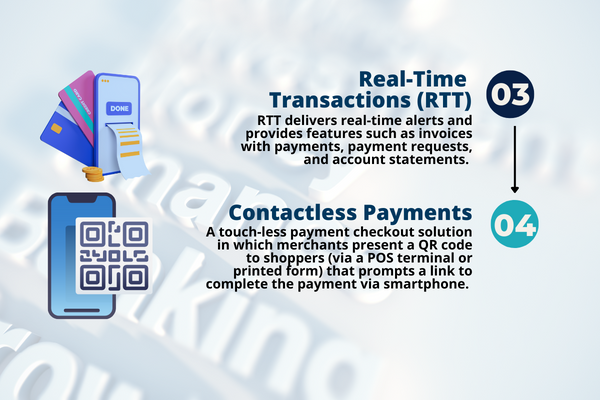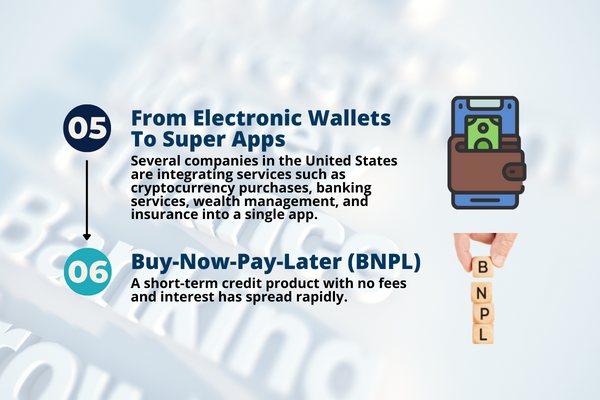DataVision was founded in 1992 with the purpose of providing clients with customisable, scalable and affordable banking software products and solutions.
Uchil Heights, Jagdishnagar, Raj Bhavan Road, Aundh, Pune - 411007, Maharashtra, India
+91-20-25690661/2/3
info@datavsn.com

The pandemic and its effects have triggered a wave of innovative payment solutions for existing applications, which have benefited both consumers and businesses.
The resurgence of investments has resulted in the development of cutting-edge payment technology-based solutions. Priority has been given to data-driven offerings that provide value-added propositions, and distributed ledger technology has garnered interest in using digital currency solutions and enhancing operational competence.
Merchants and retailers are integrating payments into their value chains, whereas technology titans are stepping up their financial services game by integrating payments into their offerings.
We anticipate the following six trends to dominate the global retail payments market in 2022.

Due to a large number of users of social media platforms and the potential payment opportunities they present, businesses must also pay attention to and capitalize on the convergence of payments and social media. Meta has implemented several dedicated product store features and store controls on its Facebook and Instagram platforms to create a destination of brand storefronts where customers can peruse offerings and make purchases.
This trend has already enticed numerous well-known and international brands to establish a presence on social media platforms to capitalize on the international customer base and visibility.
According to a report by Accenture, global social commerce sales reached USD492bn in 2021; this trade is projected to increase at a positive CAGR of 26% and surpass USD1.2tn in value by 2025. In addition to strategic partnerships, social platforms, brands, and retailers are anticipated to contribute significantly to the expansion of this market.
Digital currencies are seen as the next step in the evolution of digital payments. Simply put, a digital currency controlled by a central bank would function similarly to cash that can be stored and accessed digitally. Digital currencies would expedite financial inclusion and address deficiencies in the current payment infrastructure.
China has already implemented the e-renminbi, a digital version of its currency, allowing merchants and consumers to conduct business without an Internet connection, credit card, or bank account. In September 2021, Sweden joined the club by launching its digital currency (krona). South Korea, Australia, Singapore, and India also intend to join and are taking the necessary steps to expedite the launch of digital currencies.

Due to the immediate availability of funds, convenience, ease of use, transparency, and safety, this method of payment is gaining significant traction among consumers worldwide. RTP delivers real-time alerts and provides features such as invoices with payments, payment requests, and account statements.
In addition, RTP’s overall value proposition is enhanced by the incorporation of contemporary features such as support for all types of utility bill payments, In-app shopping, and P2P payments.
Financial institutions are investigating additional use cases to pave the way for innovative and seamless payment offerings for consumers and businesses. Fifty-four countries have adopted RTP systems, and several others are developing them. Existing systems are being modernized with innovations and interoperability for international transactions.
According to a recent article published by ACI Worldwide and Global Data, the number of real-time transactions in 2020 was 70,3 billion, up 41 percent from 2019; the value of transactions increased 33 percent y/y to USD69 trillion in 2020. In 2020, RTP accounted for 9.8 percent of all global electronic transactions, up from 7.6 percent in 2019; by 2025, this proportion is projected to reach 17.4 percent. India ranked first in the report, with 25,5 billion transactions, followed by China with 15,7 billion transactions.
The pandemic has accelerated the adoption of contactless payments. It acted as a catalyst for innovation: payment service providers such as Square and Adyen launched touch less payment checkout solutions in which merchants present a QR code to shoppers (via a POS terminal or printed form) that a link to complete the payment via smartphone. PayPal introduced comparable functionality in the United Kingdom, and other providers worldwide are expected to follow suit.
Near-field communication (NFC) payments technology for card-based payments holds a bright future due to its improved security standards and usability, allowing customers to tap or wave their mobile devices to pay.
The expansion of smartphone usage, Internet connectivity, and merchant networks would accelerate the growth of QR-based payment options and other contactless payment methods. According to the International Telecommunication Union, Internet users will reach 4,9 billion in 2021, up from 4.1 billion in 2019. (ITU).

Digital wallets have achieved great success in emerging markets such as China and India, and they appear to be evolving into payments super apps (e.g., We Chat and Paytm). Several companies in the United States are integrating services such as cryptocurrency purchases, banking services, wealth management, and insurance into a single app, thereby eliminating the need for separate apps and customer accounts.
For instance, Google Pay will enable users to open checking and savings accounts with traditional banks that can be managed through the app. Similarly, Square has added new features to its digital wallets, such as cryptocurrency trading and deposit services. To create an all-in-one digital wallet solution, PayPal has also announced some interesting new features, visibly in-app shopping tools, crypto trading, interest-earning savings accounts, direct deposits, and bill payments.
Globally, the BNPL payment option, a short-term credit product with no fees and interest, has spread rapidly. Due to its ability to offer installment products to consumers underserved by traditional financial institutions, its global adoption by merchants is growing. Its increasing popularity among consumers can be attributed to its straightforward pricing models, convenience, and user-friendliness (no credit history or other proof needed).
The BNPL option provides credit access in a decentralized, democratic, and inclusive manner, opening a market previously dominated by global credit card network providers and traditional financial institutions. Fintech and traditional financial institutions invested significant capital in strengthening their foothold; for example, Square acquired Afterpay for USD29 billion, and PayPal purchased Paidy for USD2.7 billion. Companies have collaborated (e.g., Klarna-Stripe and Amazon-Affirm) to take advantage of each other’s expertise and geographic reach. It facilitates cross-pollination and accelerates business growth.
In this age of digitalization, customer preferences are rapidly changing, and technologies are becoming obsolete at an unprecedented rate. Companies must now innovate and invest in new payment solutions to remain competitive and increase their share of the volume and value of customer payments.
Governments and payment bodies/regulators are constructing the regulatory frameworks required to monitor the development of payment technology, combat fraud, and protect user interests.
How Can Datavision help?
On their digital transformation journey, we assist a variety of financial institutions and global banks. Our one-of-a-kind approach, which combines people, process and technology expedites the delivery of superior results to our clients and drives excellence. Several reputed companies leverage our proprietary suite of business excellence tools and services to unlock new growth levers and unparalleled ROI.
Datavision stands proudly as a prominent banking software solutions provider, recognized for our unwavering commitment to excellence in the industry. We have earned our esteemed reputation by consistently delivering cutting-edge core banking software, catering to the needs of both retail and corporate banking software sectors. At Datavision, our mission is clear: to provide our clients with the best banking software products, ensuring that they stay ahead in an ever-evolving financial landscape. We take pride in serving our prestigious clients and look forward to continuing our journey of innovation and excellence.
Get in touch with us for customizable, scalable, and affordable banking software products and solutions. Our portfolio of banking software product and services include:
Core Banking Solutions
FinNext Core | FinNext Islamic Banking | FinTrade | EasyLoan | MicroFin
Digital Banking Solutions
IBanc | MobiBanc | MBranch | FinTab | FinSight
Risk & Compliance
FinTrust | InvestRite
Want to know how our team of experts at Datavision offer our reputed clients customisable, scalable and affordable banking software products and solutions? Visit us to know more.
 The “ENGINE” Framework: Transforming Developers into Engineers
April 11, 2025
The “ENGINE” Framework: Transforming Developers into Engineers
April 11, 2025
 Ensuring Compliance in Financial Software Development
March 31, 2025
Ensuring Compliance in Financial Software Development
March 31, 2025
 The Role of Microservices in Modernizing Core Banking Systems
March 19, 2025
The Role of Microservices in Modernizing Core Banking Systems
March 19, 2025
 How Blockchain is Impacting the Future of Banking
March 3, 2025
How Blockchain is Impacting the Future of Banking
March 3, 2025
 Data Privacy in Financial Services: Best Practices and Strategies
February 14, 2025
Data Privacy in Financial Services: Best Practices and Strategies
February 14, 2025
 Improving Trade Finance Operations through Technology
January 30, 2025
Improving Trade Finance Operations through Technology
January 30, 2025
 The Future of Mobile Banking: Trends and Predictions
January 16, 2025
The Future of Mobile Banking: Trends and Predictions
January 16, 2025
 A Guide to Effective API Management in Financial Services
December 31, 2024
A Guide to Effective API Management in Financial Services
December 31, 2024
 Top Challenges in Developing Secure Fintech Applications
December 16, 2024
Top Challenges in Developing Secure Fintech Applications
December 16, 2024
 Best Practices for Implementing EFT Switch Solutions
November 30, 2024
Best Practices for Implementing EFT Switch Solutions
November 30, 2024